Leather Braiding Bruce Grant Pdf Download
Introduction: Making Braided Leather
Leather is a great material for braiding and weaving. It is soft and pliable and can be cut into different numbers of strands easily using the same techniques that I teach in my How to Make Leather Fringe Instructable.
Standard 3 strand leather braids have a very specific, and slightly kitsch aesthetic, but the basic techniques you use to make braids are the foundation for some much more complex and interesting woven and braided leather designs.
In this Instructable, I'll show you a few of my favorite braid patterns to give you an idea of the possibilities of leather braiding. If you are looking for more great introductory leather instruction, check out my free Beginning and Intermediate Leatherworking Classes, and my Instructables on Multifunctional Leather Bags and How to be an Elf where I incorporate leather braids various designs.
Step 1: Tools and Materials
Step 2: Standard 3 Strand Braid
To make leather braids, one of the easiest ways is to start by using one of the fringe cutting techniques I talk about in my How to Make Leather Fringe Instructable, and then braid the cut strips together. This is a nice way to create a braid, because it means that, on one end of the braid, the individual strips are already attached and won't need to be held in place by another finishing method.
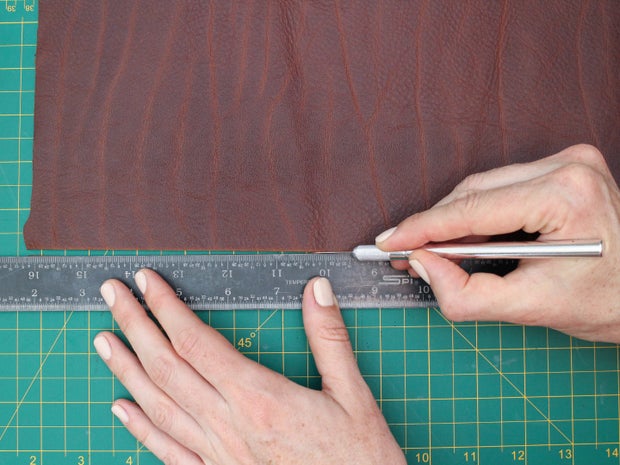

To create the basic 3 strand braid this way, first decide how long and wide you need your braid to be. Braiding will take up some of the length of your leather, so you need to account for that. Braiding usually causes a length shrinkage of around 1/4 depending on the thickness of the leather and the width of your strips. So if you want a 9" long braid, you need to start by cutting strips about 12" long.
Braiding also causes a width shrinkage which varies with the thickness of the leather, but a braid like the one I'm making shrinks about 1/4" in width.
To make the basic braid, cut a three stranded fringe, then find a way to hold the top end in place so you can braid more easily. I like to use a binder clip and then loop the handles around something.
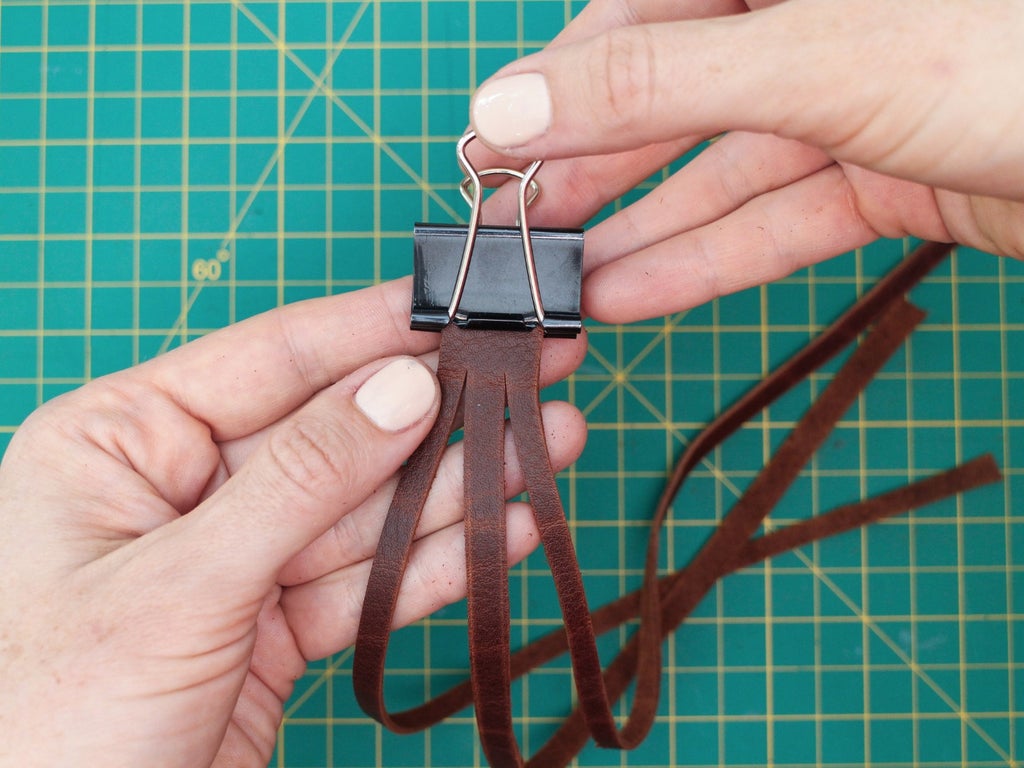
Now make your braid the way you would a normal braid, by alternating sides taking a strip from the outside and crossing it over into the middle. Don't let your strips flip upside down, make sure the grain side is always facing up.

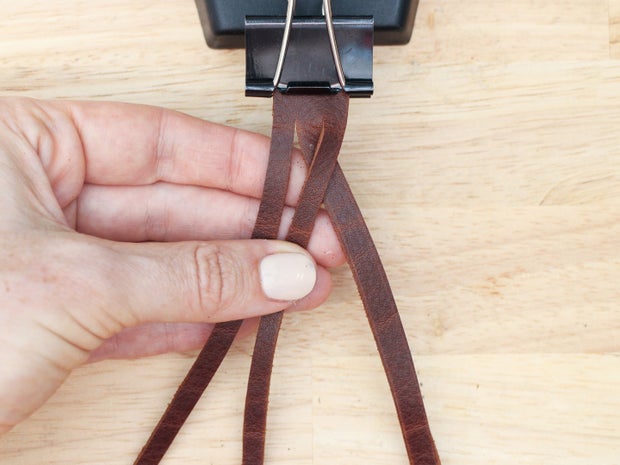
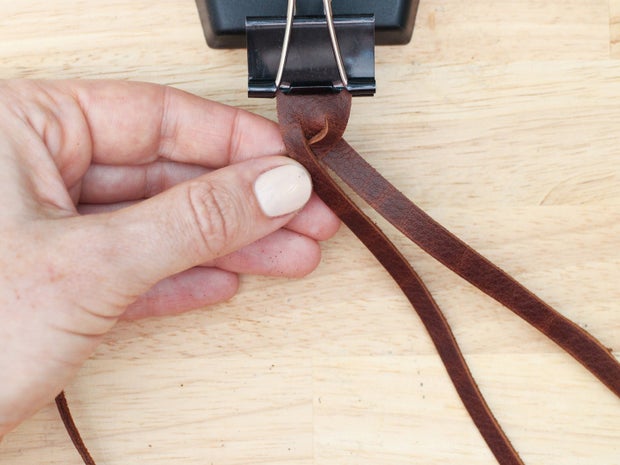
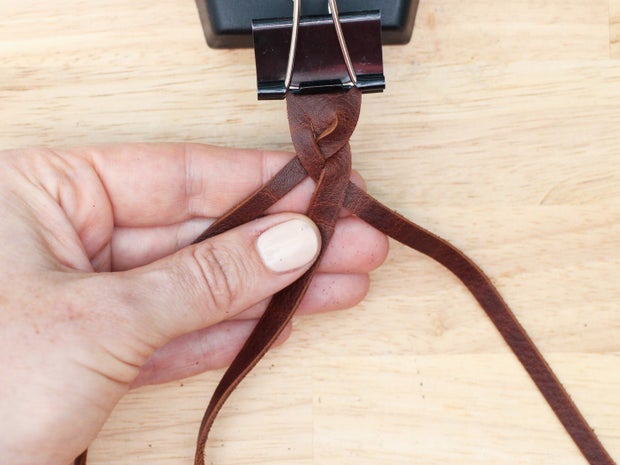
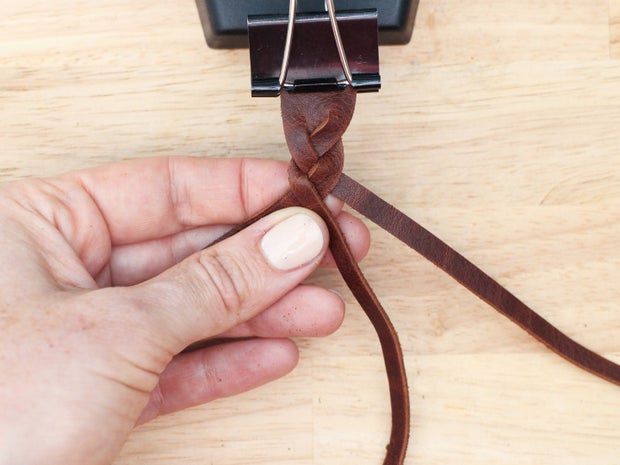
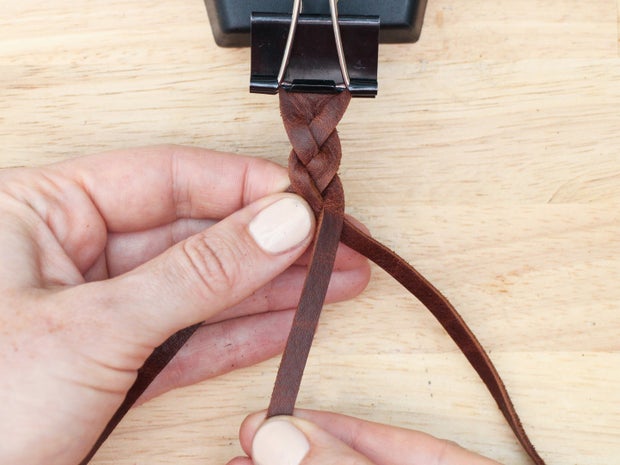

Step 3: 3 Strand Trick Braid
The 3 strand trick braid looks like a regular braid, but it is closed at both ends which makes it look impossible in an intriguing way, and also means you don't have to find a way to finish either end. It's a fun braid to have in your repertoire, especially for creating small accessories like bracelets.
To make this braid, start by cutting three strands out of a strip of leather like you did for the 3 strand braid, but leave them connected at both ends. If you are using thick or stiff leather, it is a good idea to punch a hole at the beginning of each cut to make them cross over each other more smoothly.

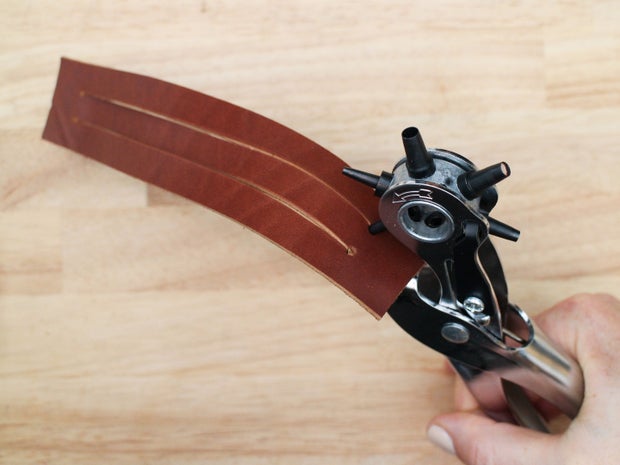
Take your strands and braid as follows: first pull the center of the right hand strip over the center strip and under the left hand strip all the way to the left side. You've basically created the beginning of a braid, but since the bottom of the strands are connected, they are crossed too, and you need to untangle them.
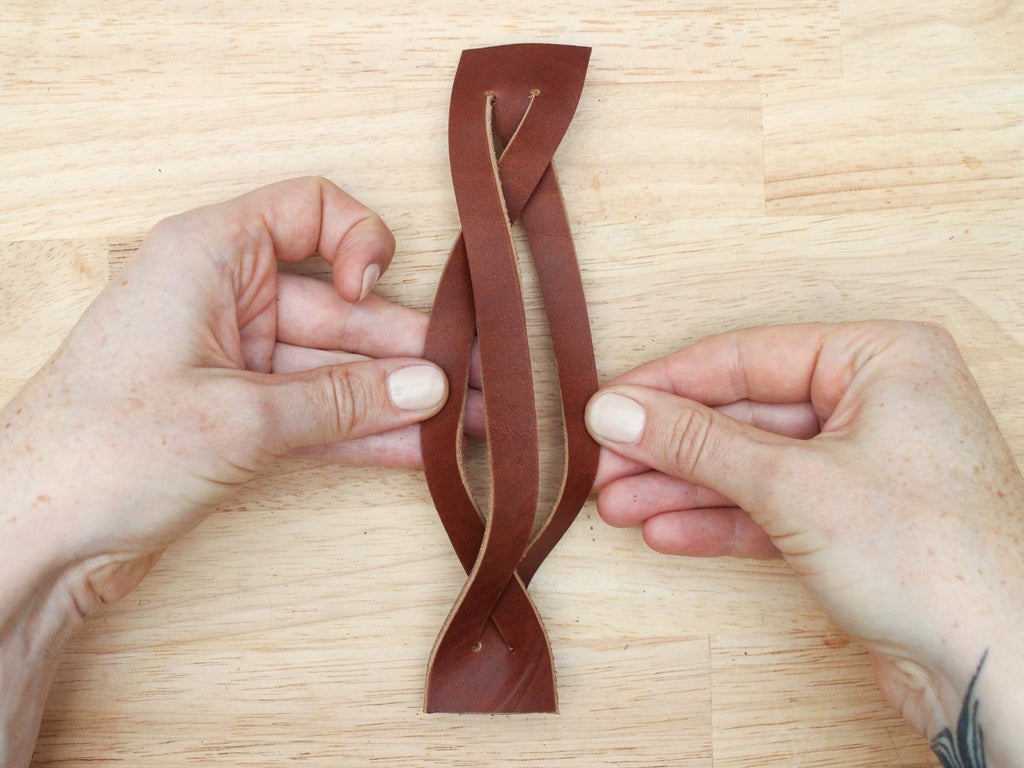
To do this, grab the bottom right hand corner of the leather, fold it up and thread it between the two strands that are currently farthest to the right.
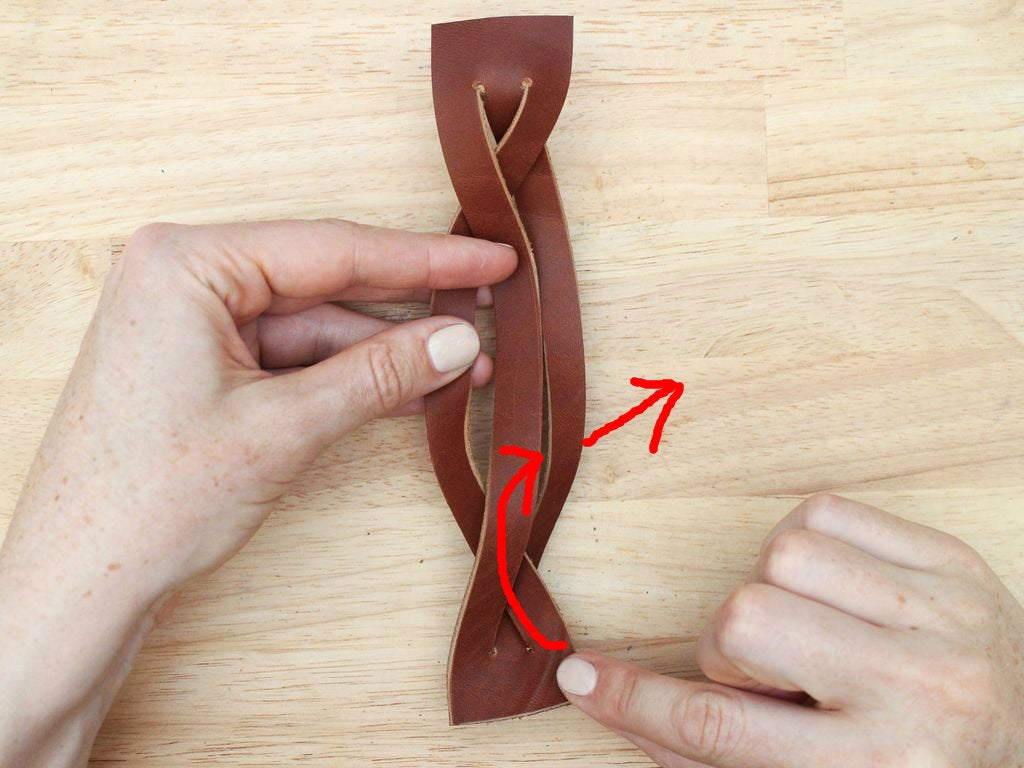

Pull it all the way through and twist it so the grain side is facing up again. You will have created something that looks a bit messy, with a lot of twists in the strands. Don't panic.
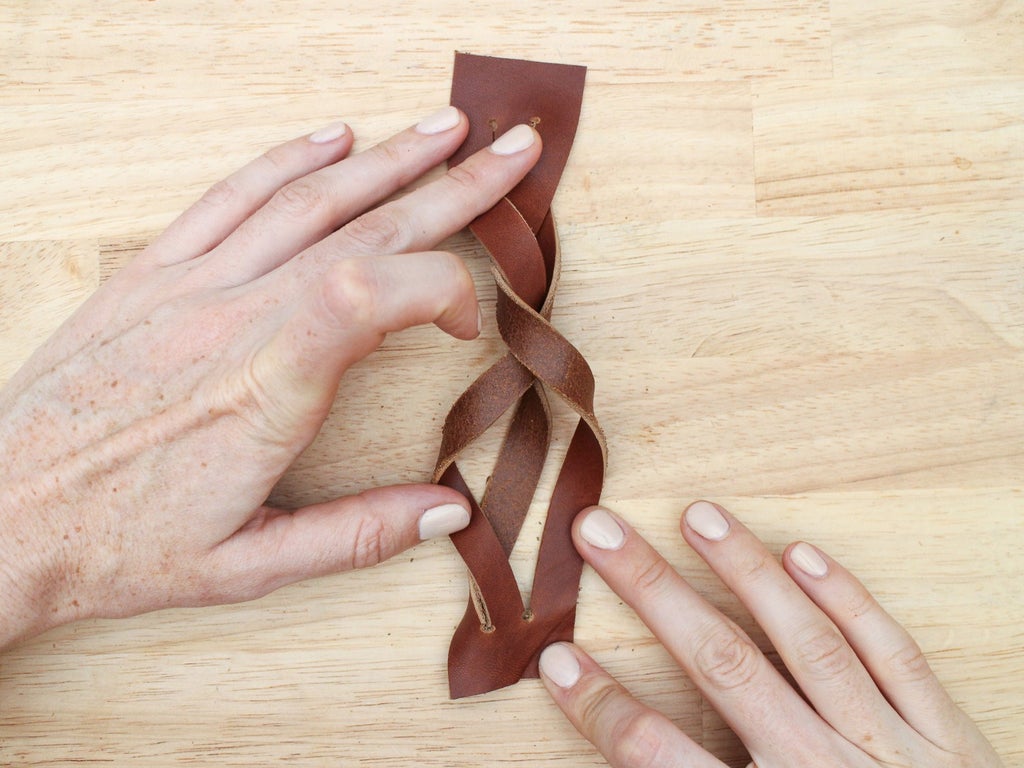
Now fold the bottom right corner of the leather up again and pass it through the space between the far left and center strands as shown below.

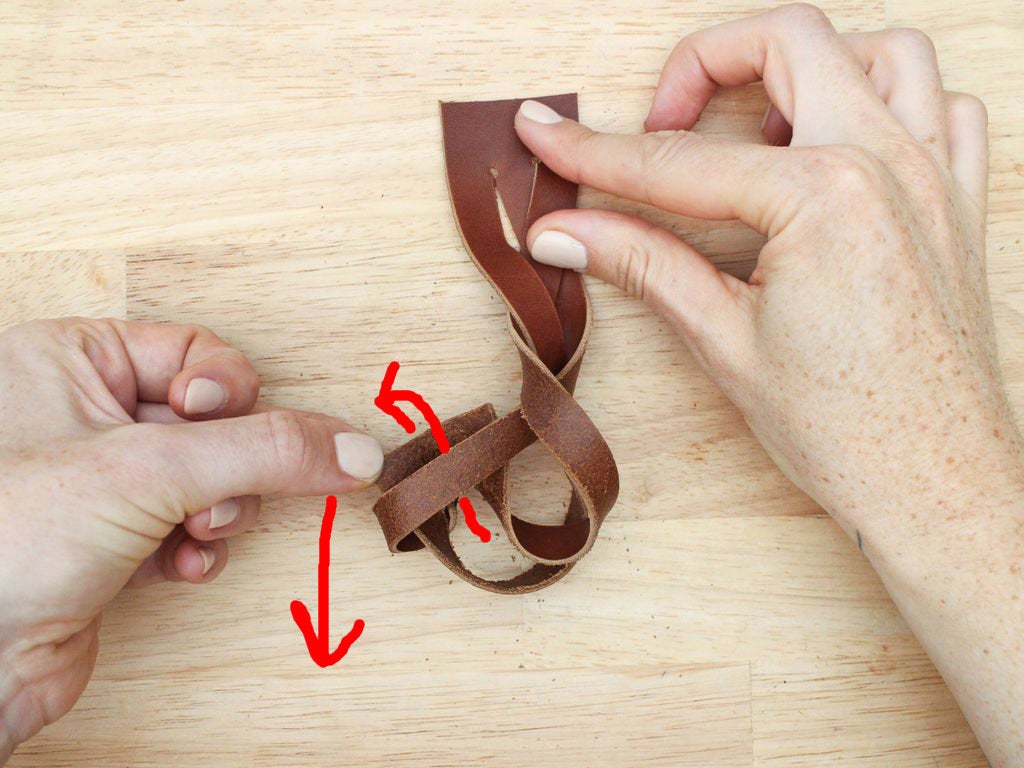
Again, you will end up with something very messy looking, but there is order under the chaos, I promise.
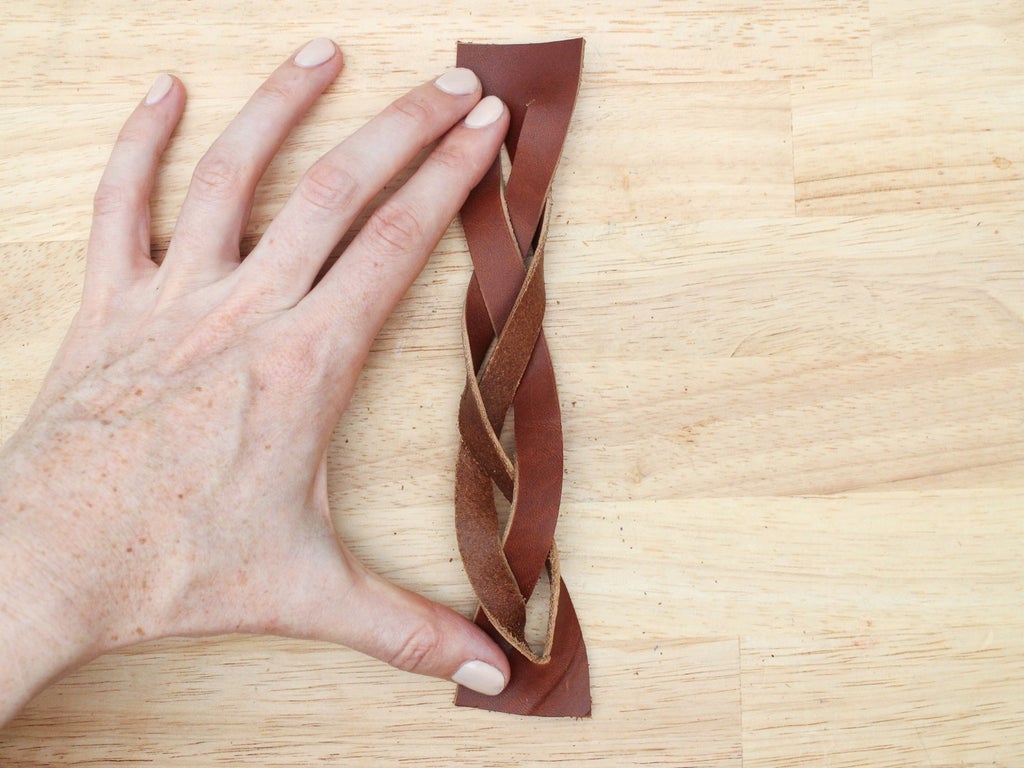
Working from the top down, untwist each strand with your fingers so the braid lays flat.
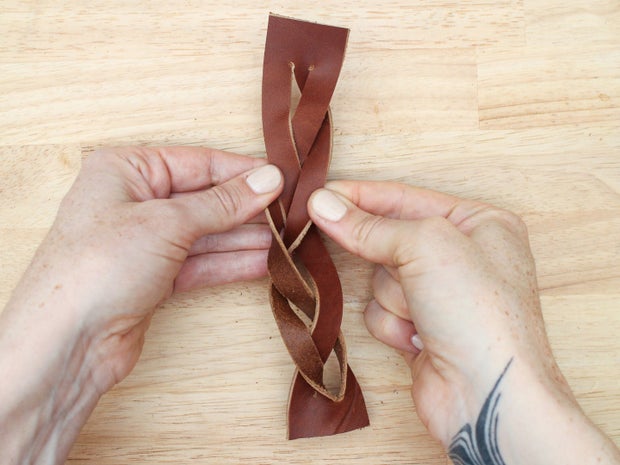
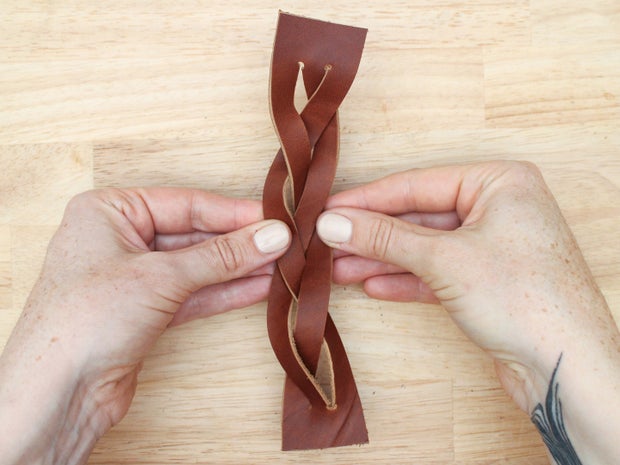
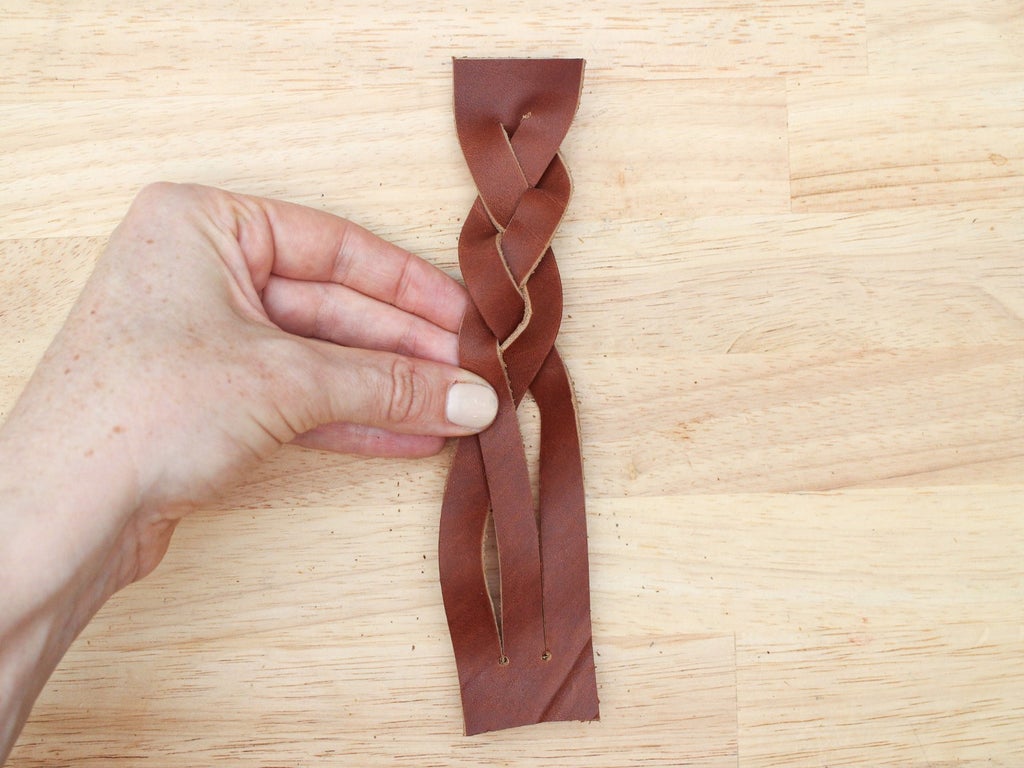
See! It's starting to look like a braid! Now start the process all over again to continue the braid. The last bit of the braid can be a bit tricky because there isn't a lot of room to weave the strands.
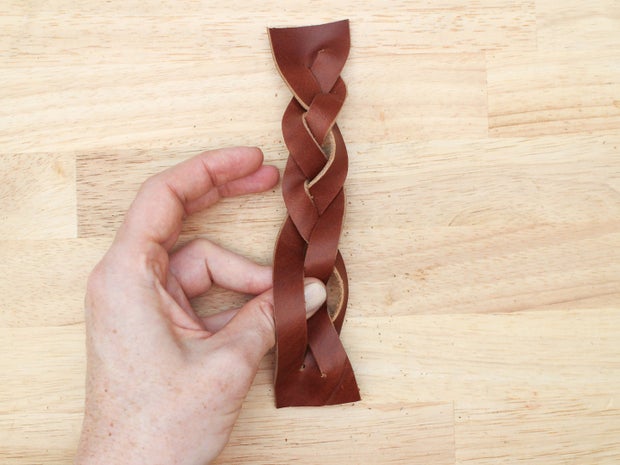
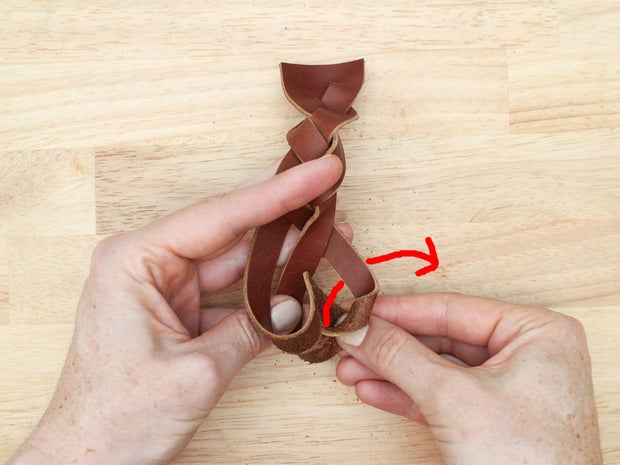
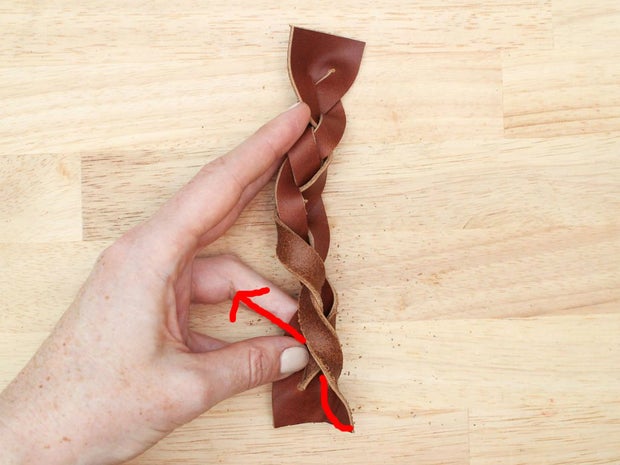

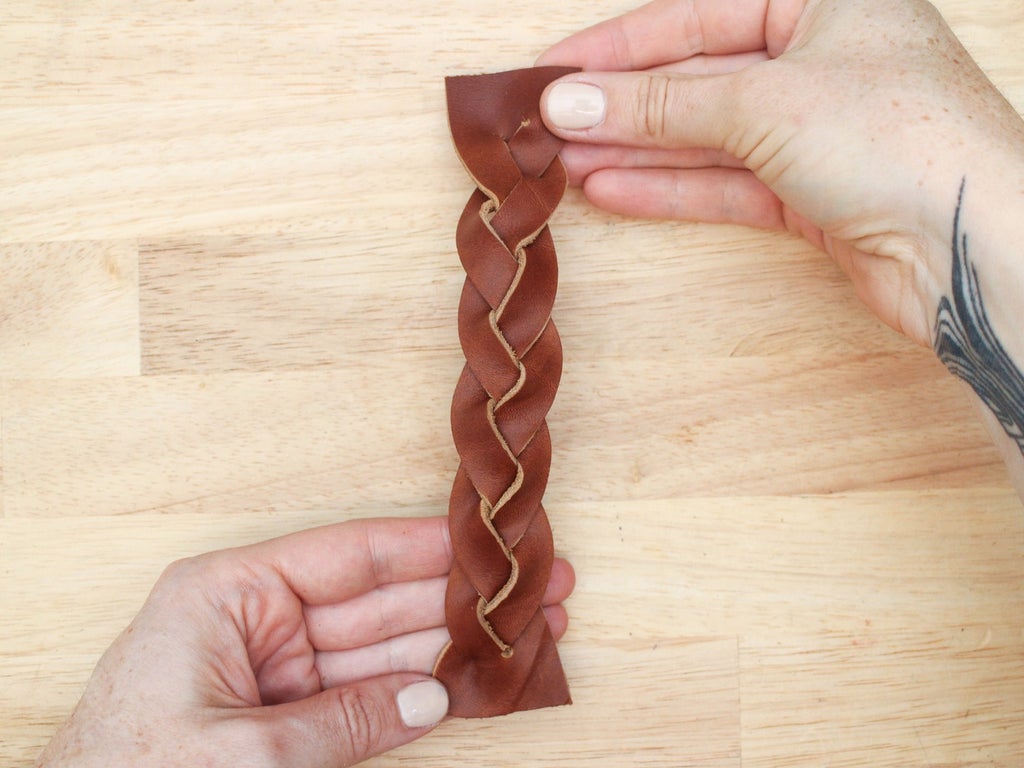
Step 4: 4 Strand Braid
There are all kinds of variations on the standard 3 strand braid. As you add more and more strands, the structure of the braids begins to look a bit more like weaving, and you can create some wide strips with interesting patterns. I'm not going to dive too deep into the world of multi strand braids here, but if you are interested in learning more, the book Leather Braiding is an excellent resource for all kinds of weaving and braid variations.
I do want to show you a 4 strand braid though, because there is something very useful about braids with an even number of strands as opposed to an odd number. You can use them as straps that go through buckles because they have gaps in the exact middle of the braid which can serve as holes for the buckle tongue!
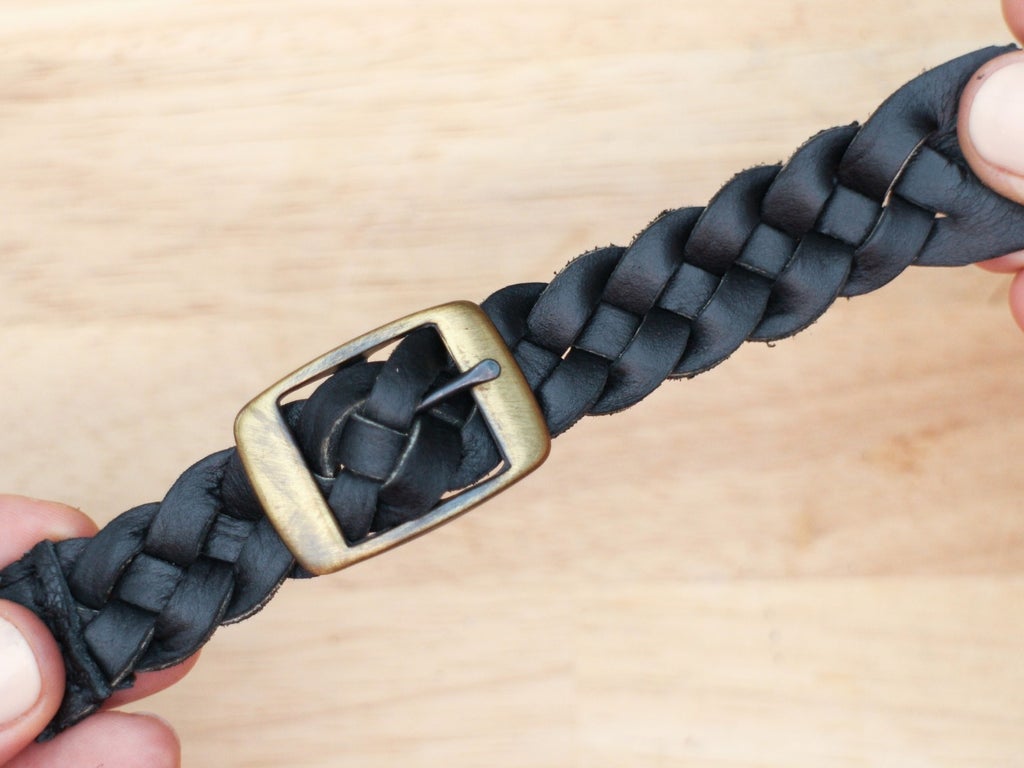
The 4 strand braid is almost as simple as the 3 strand. For this braid, just start out with 4 cut strips instead of 3.
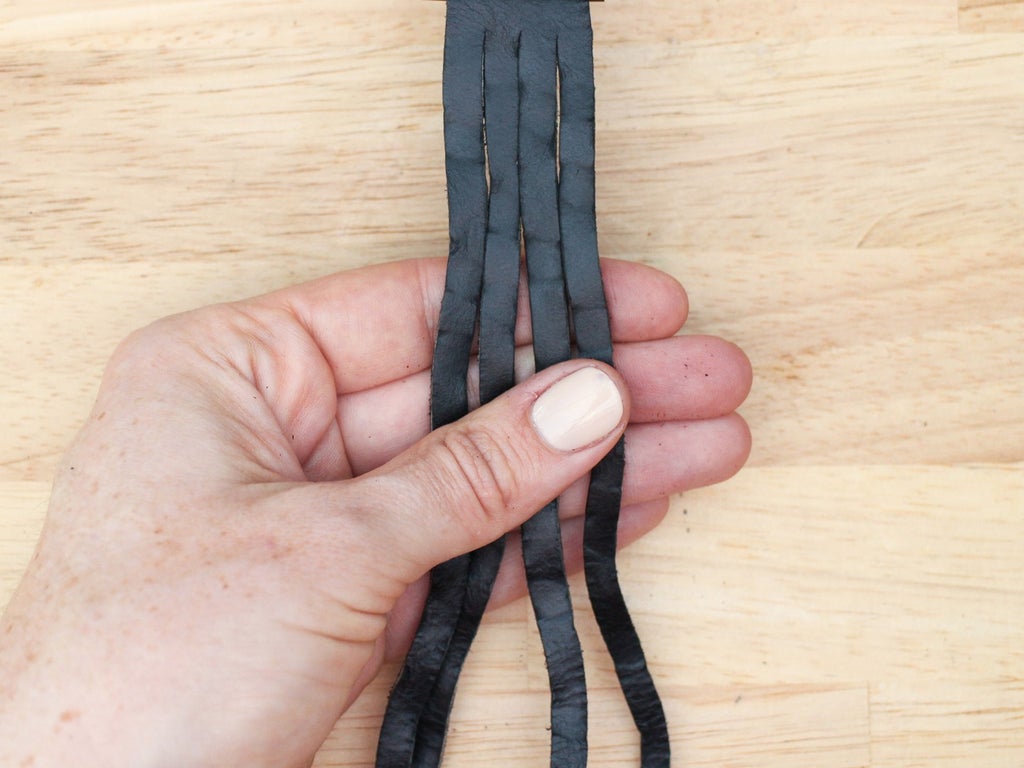
To make the braid, start by crossing the two center strips, right over left. Then bring the far left strip over the center right strip.
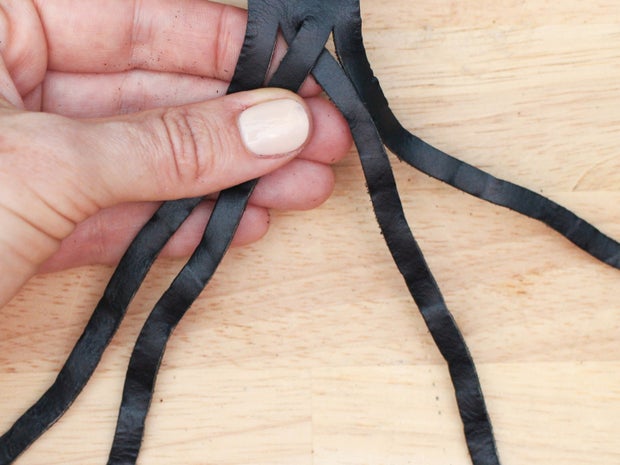
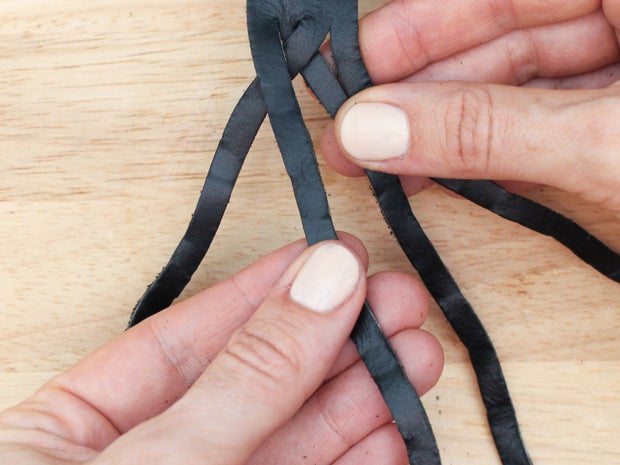
Next cross the far right strip under the center left strip and over the far left strip. Continue in the same rhythm to create the rest of the braid. You will always be bringing the strand on the left side into the center by going over, and then the strand on the right side into the center by going under then over.
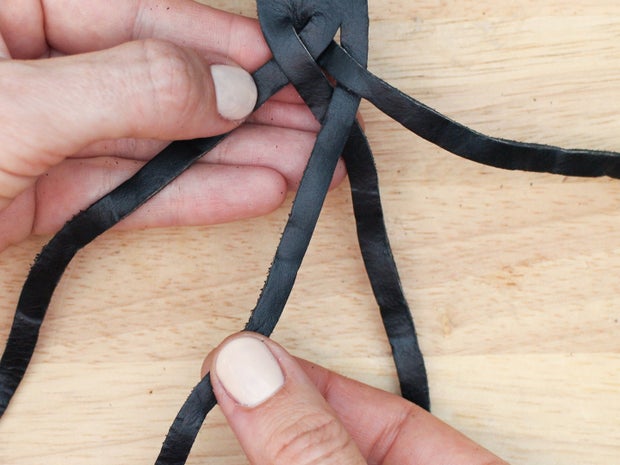
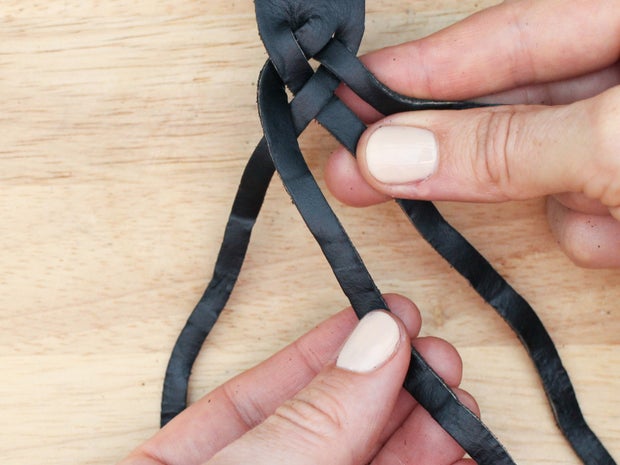
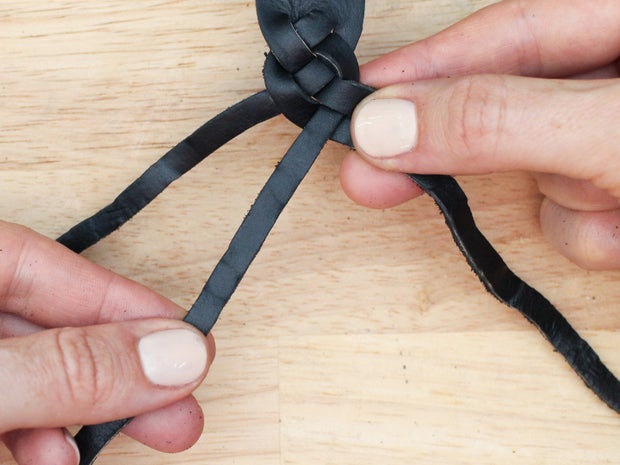

As with the 3 strand braid, keep the grain side up and the tension on your strands equal as you braid so the weave looks even.
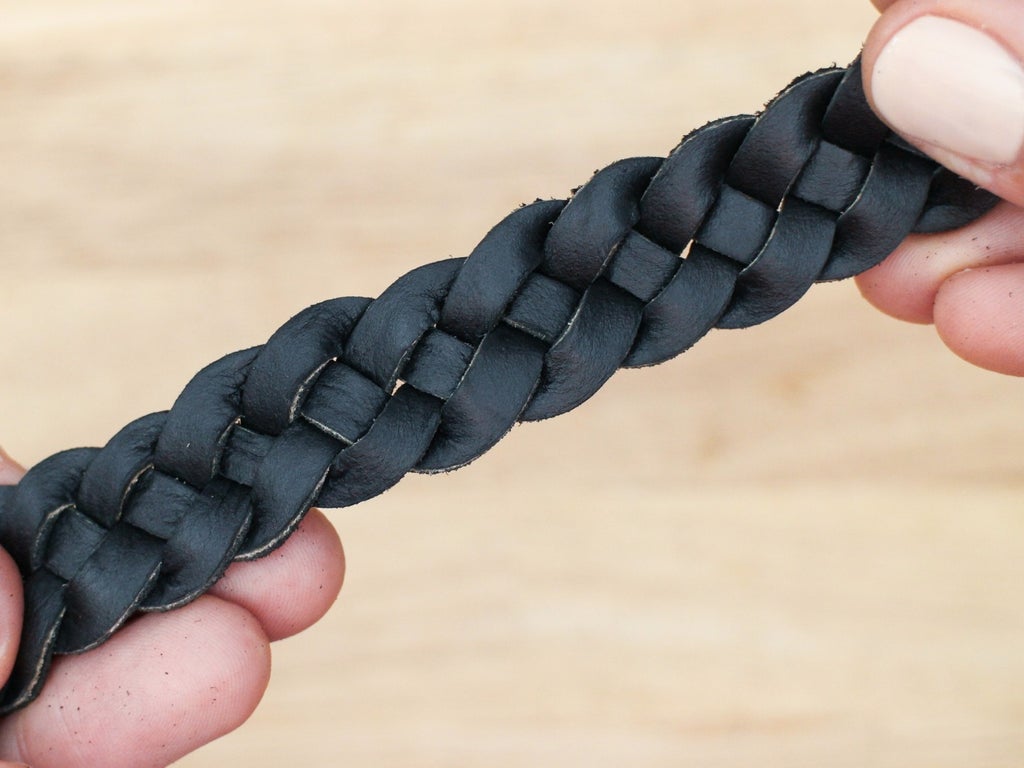
Step 5: 4 Strand Round Braid
To give you one more example of the variety of braids you can create, here's another one of my favorite patterns: the 4 strand round braid.
The finished braid has a really nice effect that is distinctly different from a traditional braid. It is especially good to use in places where you will be able to see both sides of the braid, because the round braid looks good from any angle. The four strand braid will reduce the original length of your laces by about 1/3, so you need to take that into account when planning your braid.
Also, In order for the braid to hide the rope properly, the combined width of the laces needs to be about the same as the circumference of the rope. For example, if your rope is 2" around, you need to use 1/2" wide strips of lacing.
As you can see below, you start the four strand braid by attaching 4 lengths of lacing around a central rope core with their grain sides facing out. A good way to do this is by wrapping thread around the tops of the laces.
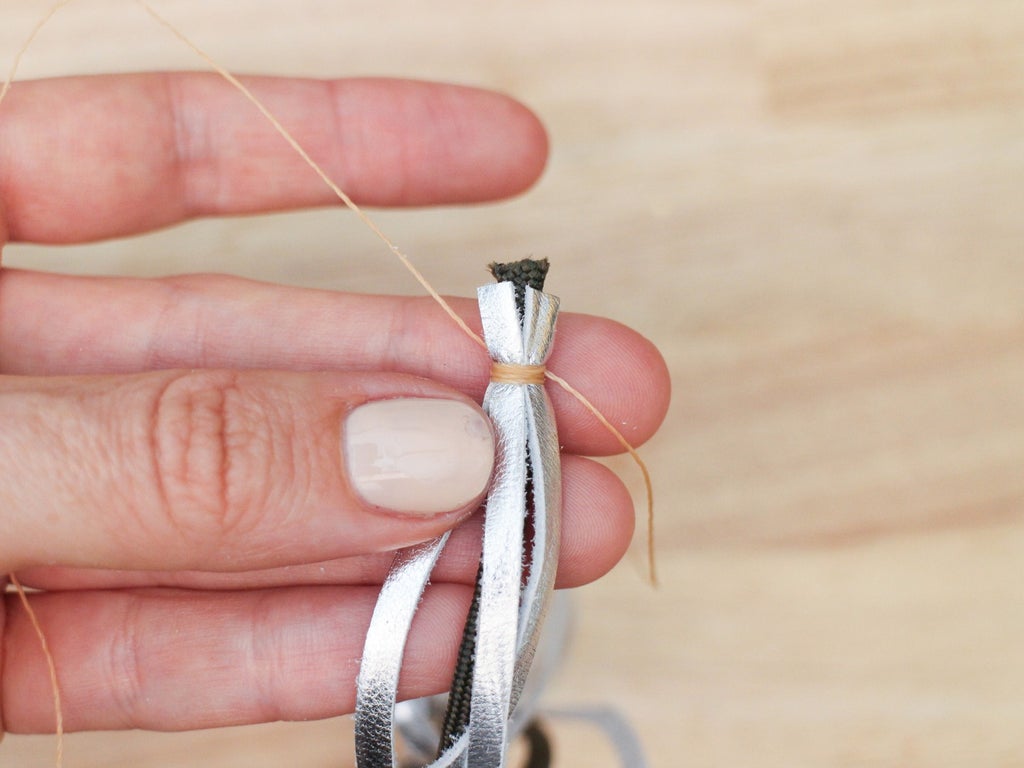
Again, secure your rope to something to leave your hands free to braid. Orient the rope so there are two strands in front and two strands in back. To make the braid, start by crossing the front left strand over the front right.
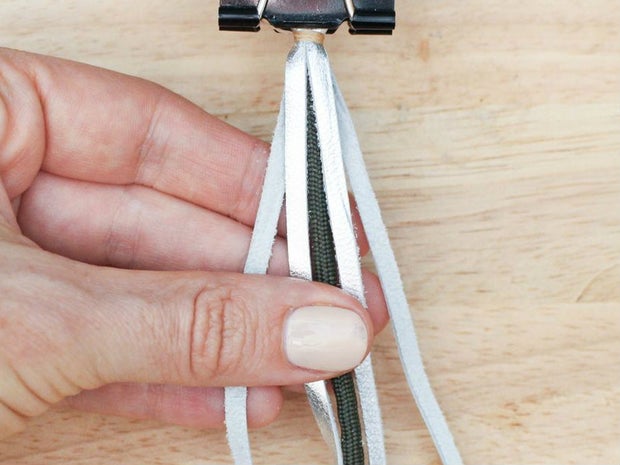
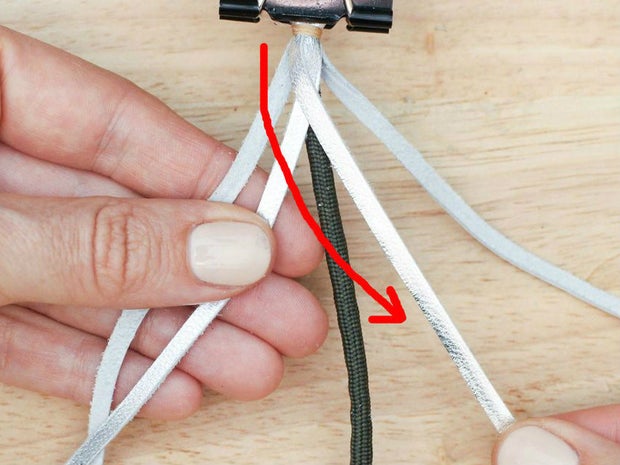
Next, take the far left strand and bring it around the back of the rope, under the far right strand and over the next strand to the left, so it is resting in the very middle of the front. Tug and tighten the strands around the rope so they begin to form the braid.
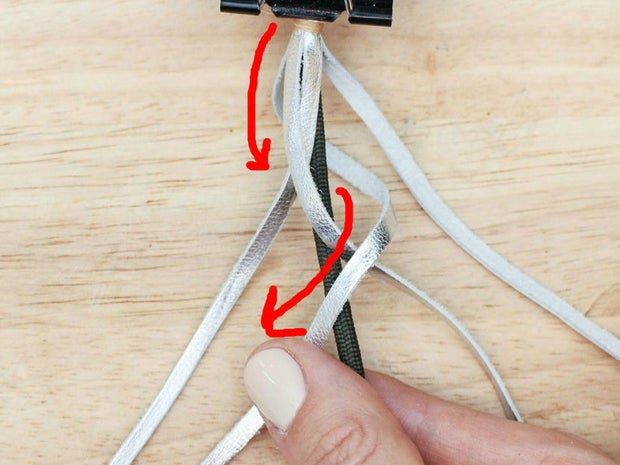
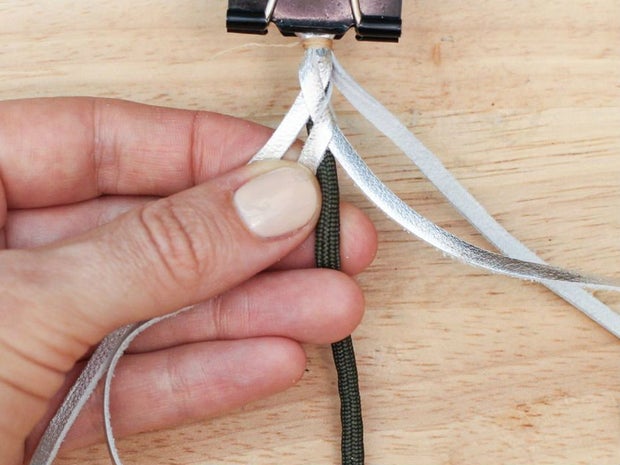
Now do the same from the right: take the far right strand (the highest strand), and bring it around the back of the rope, under the far left strand and over the next strand to the right, so it is resting in the very middle of the front. Tug the strands to tighten the braid.
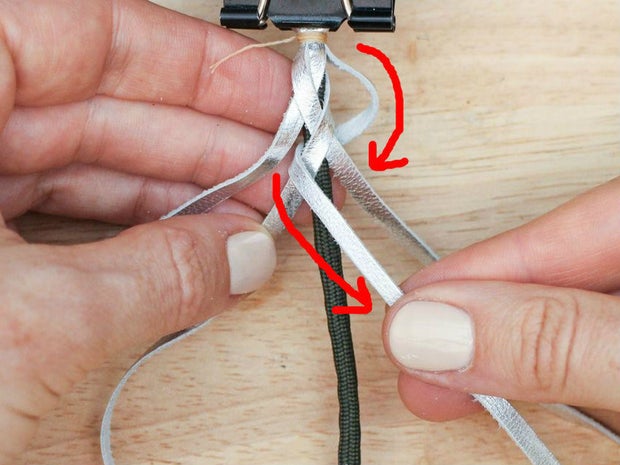
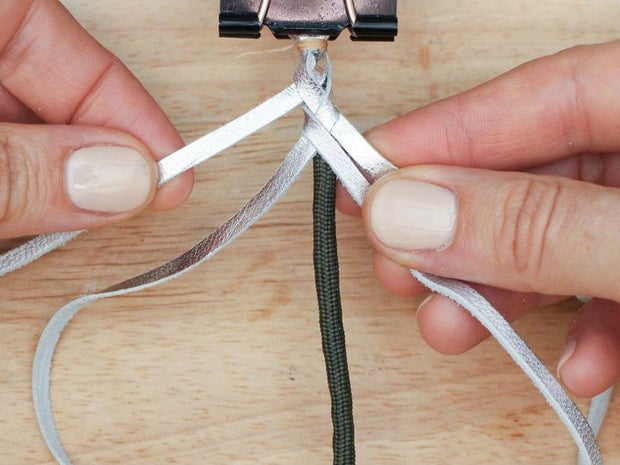
As you can see, you are basically always taking the highest strand from alternating sides, and wrapping it around the back of the rope to the other side and under the next highest strand. Keep working in this pattern to make the rest of the braid. Always keep the grain sides of the lacing facing out and don't let them twist.
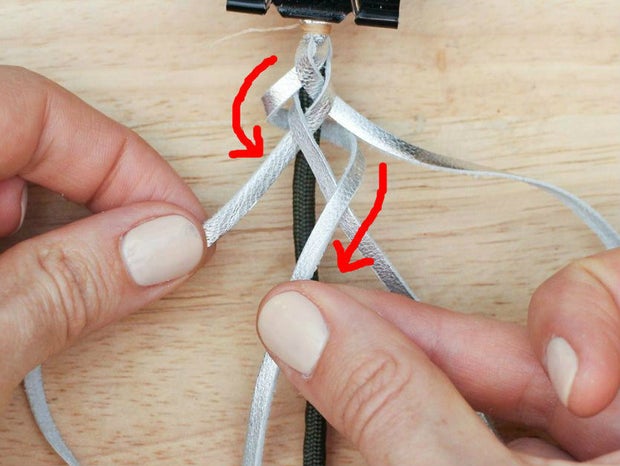
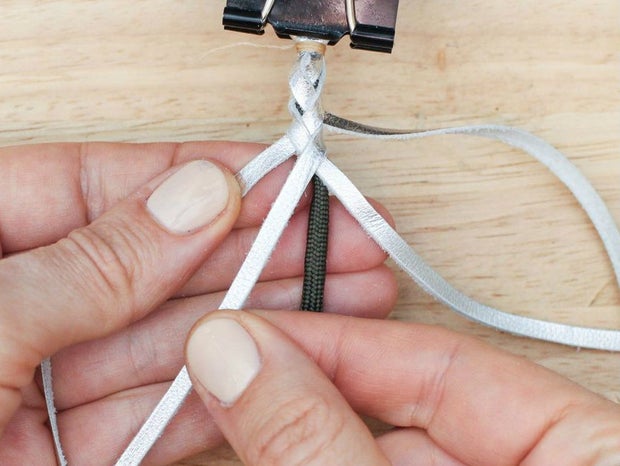

This braid is really quite easy once you get the pattern, but here's a diagram in case you're still feeling confused:
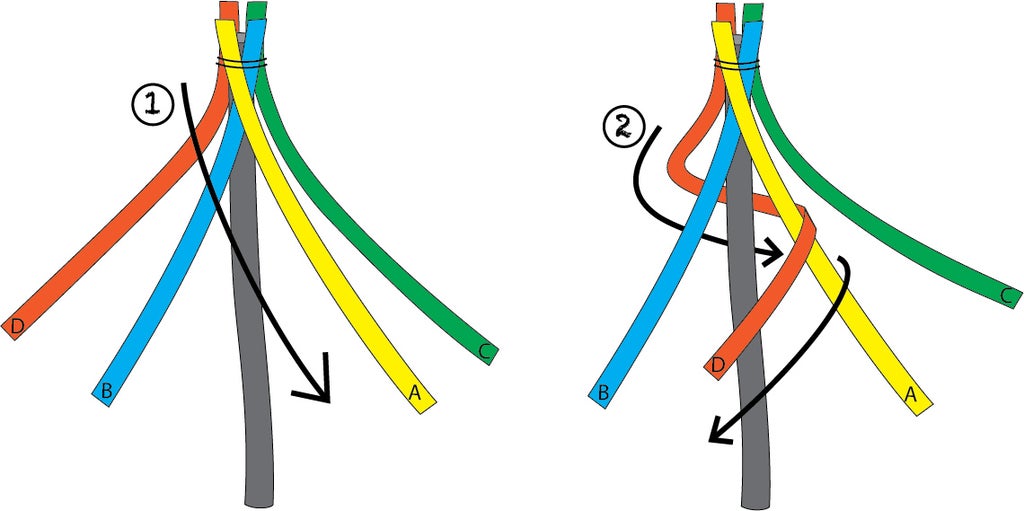
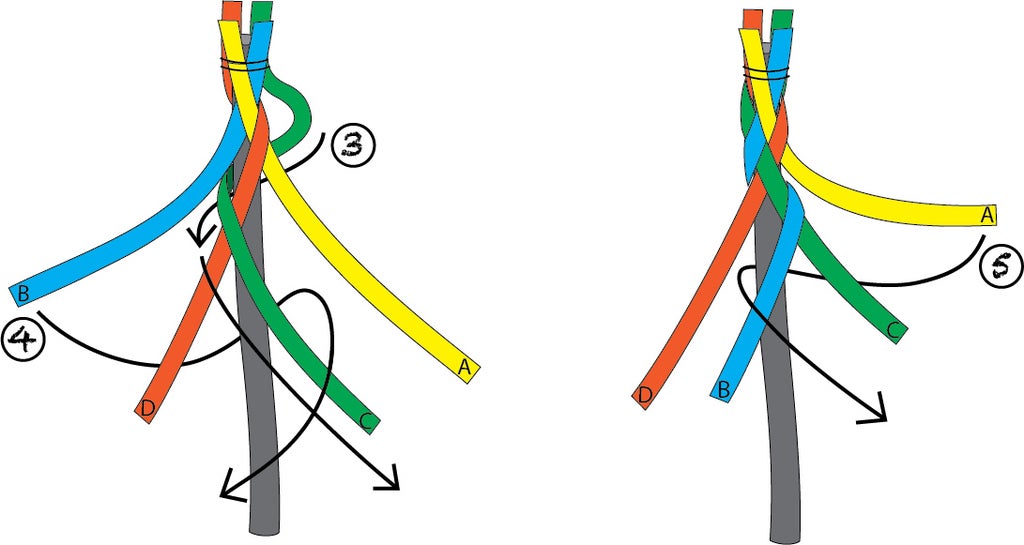
Step 6: Finishing Braids
If you want to incorporate a free hanging braid into your project you need to find a way to finish the end of the braid so it won't unravel. There are a few different ways to do this. They are all a little tricky, so if you can find a way to incorporate braiding into a project where both ends are hidden inside seams it will make things simpler.
If you do want to try a hanging braid, you can either keep the strands of the braid free at the end or cap the braid so you don't see the loose ends. If you are ok with seeing the ends of the lacing, you can wrap thread or another piece of lacing around the end of the braid almost the way you would with a hair tie at the end of a hair braid.
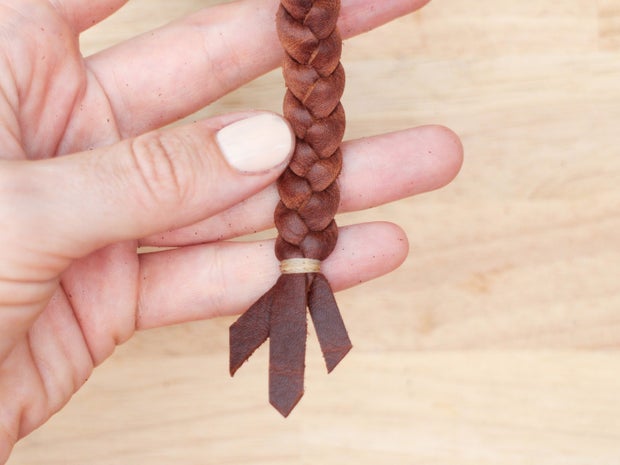
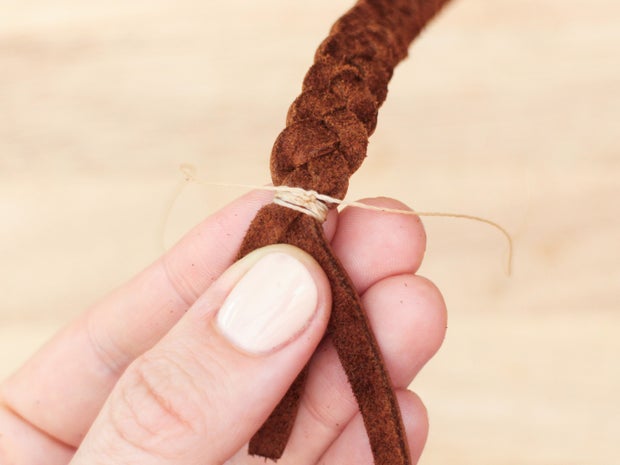
If you use lacing or a strip of leather here, you need to sew together or glue down the ends of the lacing.

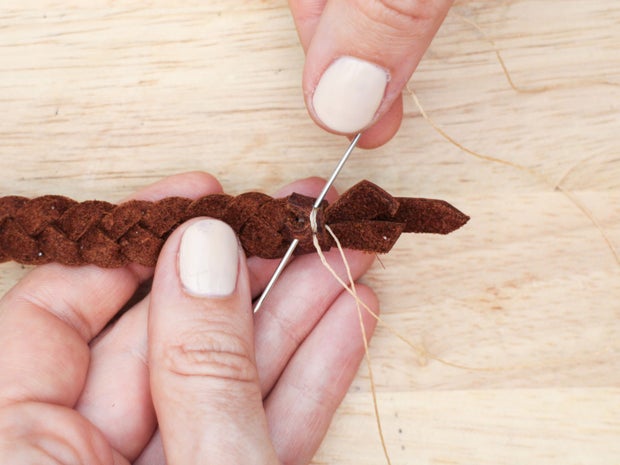
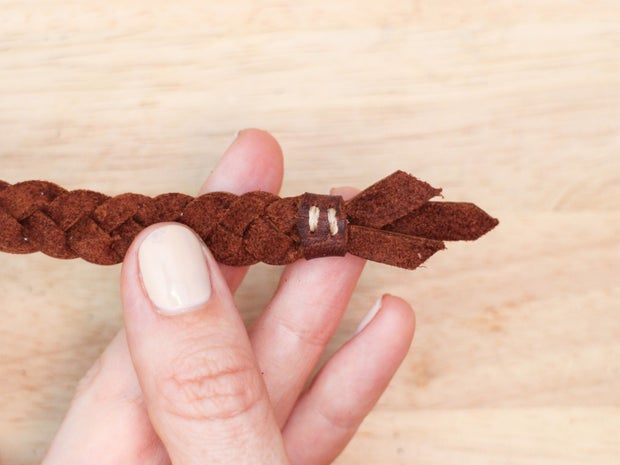
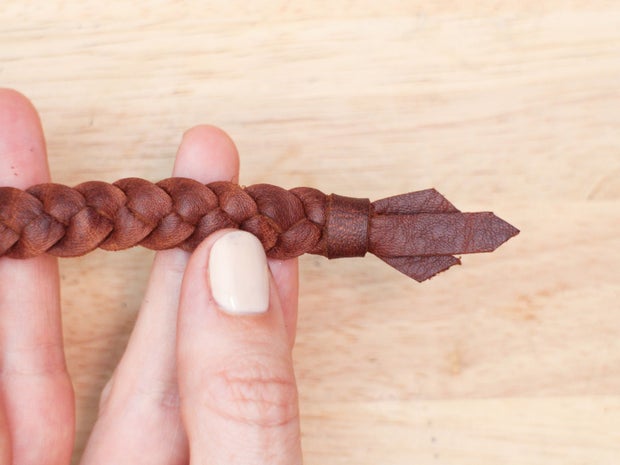
It can look a bit more professional, however, to cap the ends of the braid with a larger piece of leather. You can do this with a two piece cap if you want to create a shaped end, or one piece folded over to create a flat end.
First apply glue to the individual strands of the braid, or punch holes in them and sew them together.
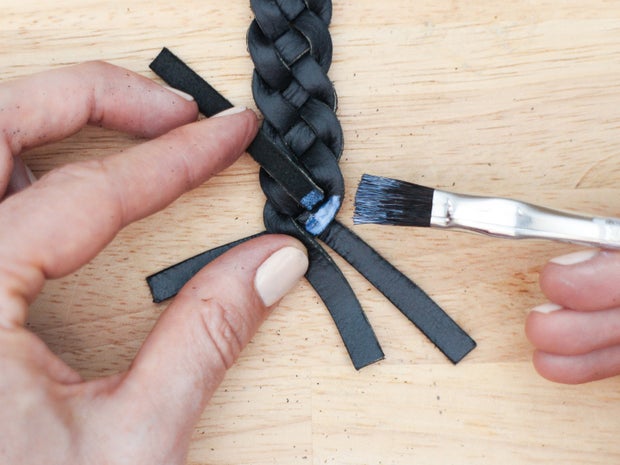
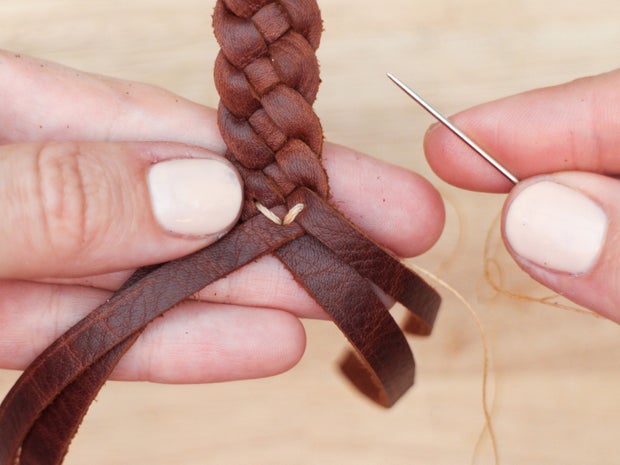
Then trim the ends to a neat shape.
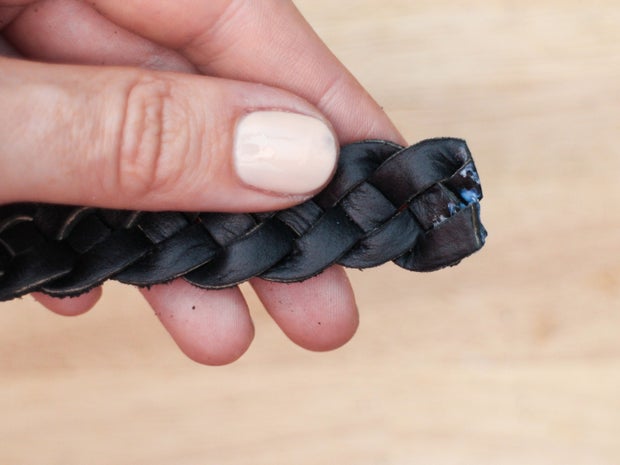
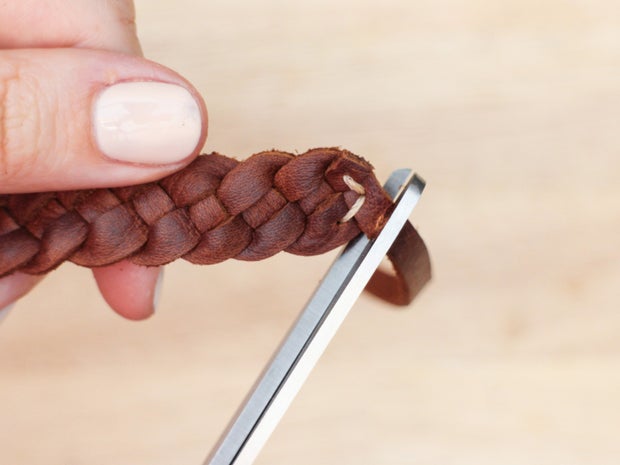
Cut one or two pieces of leather to form the cap you want to create. If you are using one piece, glue the cap down over the end of the braid, sandwiching the laces, then use one of the punching methods we've learned to punch sewing holes through all three layers. If you are making a two piece cap, sew the front edge of the cap first, glue it over the braid and punch the rest of the holes.
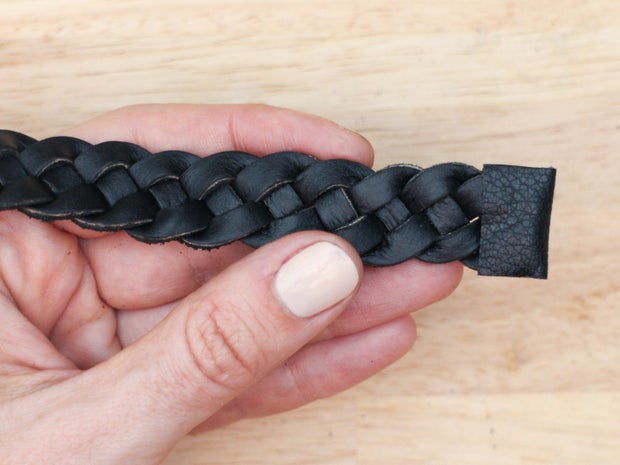
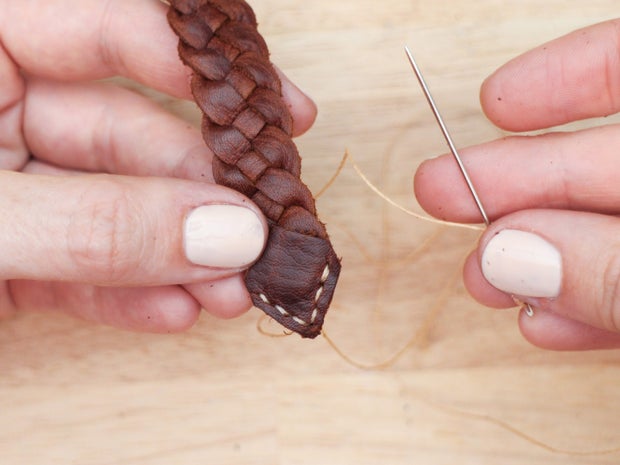
Sew the cap onto the braid with a saddle stitch.

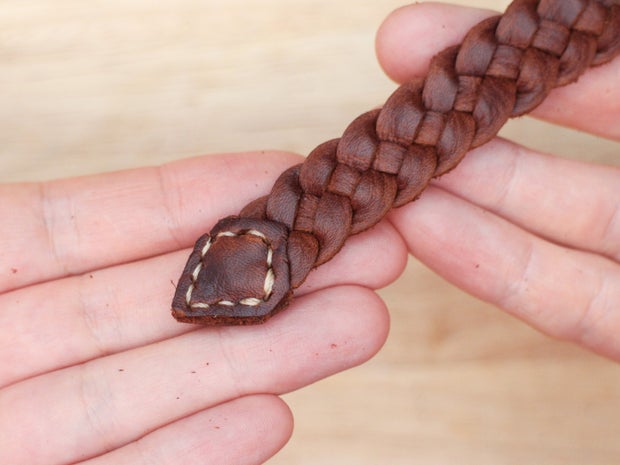
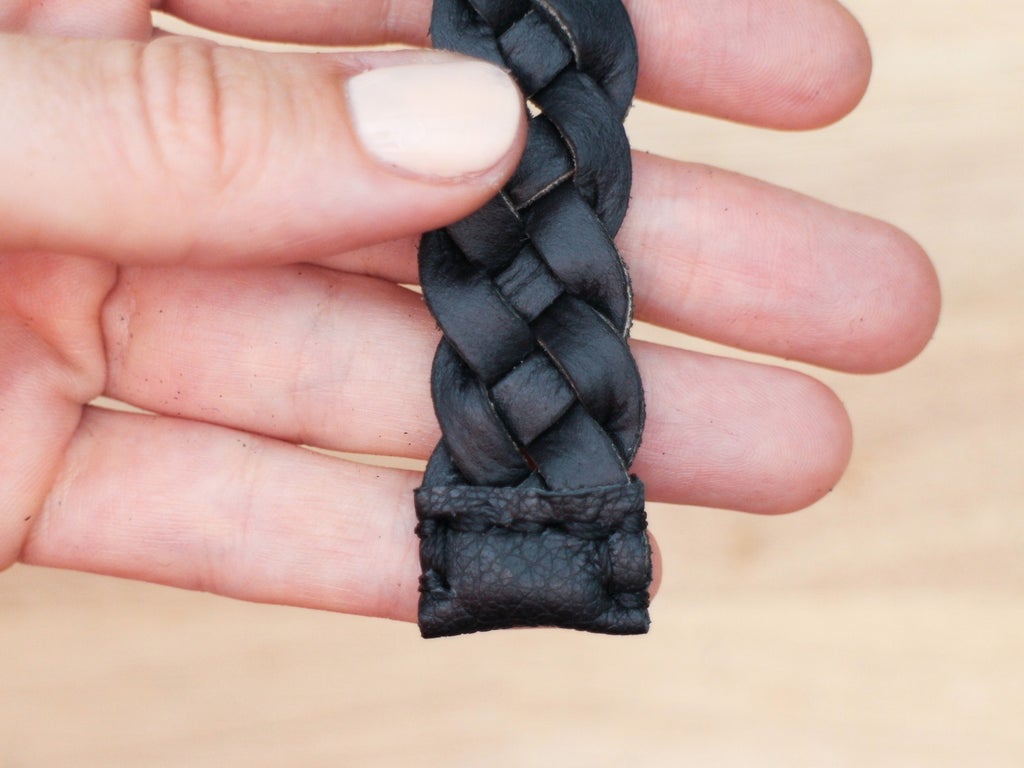
Step 7: Add Braided Details to Your Designs
I've shown you 4 different braid variations that I hope give you a good idea of the possibilities of leather braiding and weaving. One of my favorite things about these kinds of techniques is that they create subtle variations in texture that add a lot of visual interest to a design. I've seen some amazingly creative versions of these patterns, and quick search on the internet will give you some great inspiration.
If you're looking for some inspiration on how to use leather braids, check out my Multi Functional Leather Bag, and How to be an Elf Instructables. I incorporated a braid into the bag design by adding a four strand braided strap across the front that holds the flap of the bag in place. And I used braids on the headpiece, bracers and belt of the elf costume.
If you've created any braids, or chosen to add one to your project, feel free to post an I Made It below! And if you are looking for some more basic leatherwork instruction to help you complete your leather projects, check out my free Beginning and Intermediate Leatherworking Classes.
Be the First to Share
Recommendations
Posted by: deneenfredae0198819.blogspot.com
Source: https://www.instructables.com/Making-Braided-Leather/
Post a Comment for "Leather Braiding Bruce Grant Pdf Download"